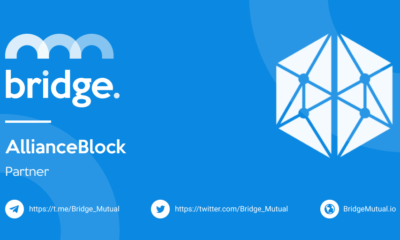Don't Miss
Ripple and SAP collaborate on international settlements using the blockchain

Banks like ATB Financial Bank Canda and ReiseBank AG Germany have been using Ripple blockchain since 2016 already.
Sometime in September, Enterprise Software maker SAP organized a chat on Twitter to explain to its users the workings of blockchain technology. The conversation focused on basic information on how blockchain could be used to improve business operations and processes, making several industries more efficient by optimizing transaction efficiency.
In the process of sharing information with their clients, SAP made known nuggets of revelations that users were quick to latch onto: SAP was testing and looking into integrating with Ripple’s default virtual currency, XRP.
The news came from SAP’s Product Marketing Consultant, Sarah Austin who doubles as an entrepreneur and content creator and has been featured in the Forbes under 30 lists. Sarah started working at SAP in 2012.
Today, it comes as no surprise that SAP is warming up and venturing into blockchain technology. As a market leader and a legend in the field of enterprise application software in the enterprise world, the German multinational company is happy to announce their collaboration with the virtual fintech company Ripple and two financial institutions in their quest to demonstrate how banks can improve their efficiency in conducting cross-border settlements by using blockchain technology.
Working in harmony, SAP and Ripple teams partnered with ATB Financial in designing and developing a proof-of-concept prototype that is based on blockchain technology. The proof-of-concept prototype was used to transfer a test CAD 1,000 US dollars settlement from ATB Financial to ReiseBank.
Going by the SAP media briefing, the settlement, that would have characteristically taken more than three business days to process due to the processes that include reconciling accounts and settling with the counterparty bank was executed end-to-end in a record time of about 10 seconds.
Demo is From 2016
ATB Financial Bank Uses ✅SAP HANA Cloud Platform and
SAP Payment Engine to Take Advantage of ✅RippleNet, Ripple and ReiseBank AG in Germany to send the first real international blockchain payment from Canada to Germany #Ripple #XRPpic.twitter.com/4ncfrimpY8— ???????????????? ???????????? (@BankXRP) October 17, 2018
The use of cryptocurrency and blockchain technology for quick, cheap, and efficient international settlements is nothing new. What is making this whole process interesting is the involvement of SAP.
With over 70,000 employees, 310,000 corporate clients globally and an estimated annual revenue of over 20 billion Euros, SAP is the world’s third principal independent software manufacturer based on market cap. The company has long been considered as the embodiment of European quality that has a robust, no-nonsense enterprise computing for large companies.
The Bridge Between Ripple’s Network and SAP, xVia
According to the definition availed by Ripple.com, xVia is one of the Ripple products tailor-made for corporates, financial institutions, banks, and settlement providers who want to transfer money across several platforms using a standard interface.
The product’s easy to understand API requires no software installation and allows users to seamlessly transfer settlements worldwide with transparency into the settlement status and with relevant information, like an invoice, attached to the payment.
Ripple’s Network
Ripple’s network which is also known as RippleNet is a decentralized global system of payment providers, financial institutions, and banks that use Ripple’s distributed financial technology. Ripple’s distributed financial technology provides real-time clearing, messaging, and settlement of monetary payments.
Enterprise Resource Planning (ERP)
ERP is a software that deals with business processes and management that allows a company to use a network of integrated applications to manage the organization and assists in automating some back-office functions that are related to technology, human resources, and services.
Oracle ERP Cloud solutions and SAP are some of the well-known examples of ERP software.
xVia as a Bridge
Being API based, xVia can be used to link these ERP software solutions such as SAP to Ripple’s network. xVia can be embedded into banks or relevant ERPs, or any application build by software providers. The everyday activities can then be driven through xVia’s API connection and then later to Ripple’s network allowing seamless software settlements solutions at one go.
In computer programming terms, an API can be defined as a set of clearly defined approaches of communication between various software components.
In summary, xVia can connect companies and firms that operate with ERP software solutions on Ripple’s Network.
For real-time trade alerts and a daily breakdown of the crypto markets, sign up for Elite membership!
Disclaimer: This article should not be taken as, and is not intended to provide, investment advice. Global Coin Report and/or its affiliates, employees, writers, and subcontractors are cryptocurrency investors and from time to time may or may not have holdings in some of the coins or tokens they cover. Please conduct your own thorough research before investing in any cryptocurrency and read our full disclaimer.
Image courtesy of Rawpixel/PixaBay
Don't Miss
A Guide to Exploring the Singaporean ETF market

Singapore’s Exchange Traded Fund (ETF) market has grown, offering investors diverse investment opportunities and access to different asset classes. As the market evolves, investors must navigate these uncharted waters with a clear understanding of Singapore’s ETF landscape. This article explores the trends, challenges and strategies for navigating the Singapore ETF market. To start investing in ETFs, you can visit Saxo Capital Markets PTE.
The Singaporean ETF Market: Exponential Growth
The Singapore ETF market has seen significant growth in recent years, with an increasing number of ETFs covering a wide range of asset classes and holders. different investment topics.
One of the notable trends in the Singapore ETF market is the growing diversity of available options. Investors can now choose from ETFs that track domestic and international stock indexes, bonds, commodities, and specialist sectors or themes. This diverse range of ETFs allows investors to create comprehensive portfolios tailored to their investment goals.
The growth of the ETF market in Singapore is also due to growing investor demand for low-cost, transparent, and accessible investment vehicles. ETFs offer benefits such as intraday liquidity, real-time pricing, and the ability to trade on exchanges. These characteristics have made ETFs attractive to retail and institutional investors who want exposure to different asset classes.
Regulatory Landscape and Investor Protection
The Monetary Authority of Singapore (MAS) is the…
Don't Miss
Property Loans for Foreigners in Singapore That You Must Know About

Intending to invest in a residential or commercial property in Singapore?
When it comes to foreigners applying for a loan in Singapore, things can be pretty hard regardless of the reason whether you need the property for personal or business purposes.
In Singapore, buying a property is challenging, whether you are a foreigner or a native, and sometimes applying for a loan is the only way for you to afford it.
HOW MUCH CAN YOU BORROW FOR A PROPERTY LOAN IN SINGAPORE?
As for the Foreigner Loans, in Singapore, there is an exact amount of money you can borrow to finance the purchase of a property.
In this sense, Singapore has the Loan to Value Ratio (LTV).
The LTV ratio is what determines the exact amount of money you can borrow for a property loan, which changes depending on where you try to obtain the loan:
- If you are applying for a bank loan, you can borrow a maximum of 75% of the value of the property you want to purchase. That means if you are looking for a property that costs $500.000, the maximum amount of money a bank lender can give you like a loan in Singapore is going to be $375.000.
- When you are applying for a loan with a Housing…
Don't Miss
CoinField Launches Sologenic Initial Exchange Offering

CoinField has started its Sologenic IEO, which is the first project to utilize the XRP Ledger for tokenizing stocks and ETFs. The sale will last for one week and will officially end on February 25, 2020, before SOLO trading begins on the platform. Sologenic’s native token SOLO is being offered at 0.25 USDT during the IEO.
Earlier this month, Sologenic released the very first decentralized wallet app for SOLO, XRP, and tokenized assets to support the Sologenic ecosystem. The app is available for mobile and desktop via the Apple Store and Google Play. The desktop version is available for Windows and Mac.
“By connecting the traditional financial markets with crypto, Sologenic will bring a significant volume to the crypto markets. The role of the Sologenic ecosystem is to facilitate the trading of a wide range of asset classes such as stocks, ETFs, and precious metals using blockchain technology. Sologenic is an ecosystem where users can tokenize, trade, and spend these digital assets using SOLO cards in real-time. The ultimate goal is to make Sologenic as decentralized as possible, where CoinField’s role will be only limited to KYC and fiat ON & OFF ramping,” said CoinField’s CEO…
-

 Blogs6 years ago
Blogs6 years agoBitcoin Cash (BCH) and Ripple (XRP) Headed to Expansion with Revolut
-

 Blogs6 years ago
Blogs6 years agoAnother Bank Joins Ripple! The first ever bank in Oman to be a part of RippleNet
-

 Blogs6 years ago
Blogs6 years agoStandard Chartered Plans on Extending the Use of Ripple (XRP) Network
-

 Blogs6 years ago
Blogs6 years agoElectroneum (ETN) New Mining App Set For Mass Adoption
-

 Don't Miss6 years ago
Don't Miss6 years agoRipple’s five new partnerships are mouthwatering
-

 Blogs6 years ago
Blogs6 years agoEthereum Classic (ETC) Is Aiming To Align With Ethereum (ETH)
-

 Blogs6 years ago
Blogs6 years agoCryptocurrency is paving new avenues for content creators to explore
-

 Blogs6 years ago
Blogs6 years agoLitecoin (LTC) Becomes Compatible with Blocknet while Getting Listed on Gemini Exchange















